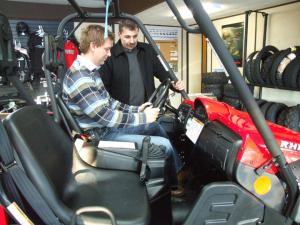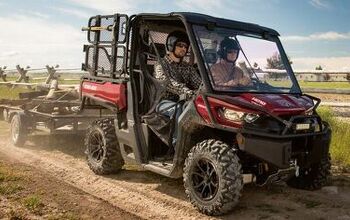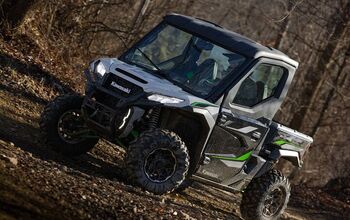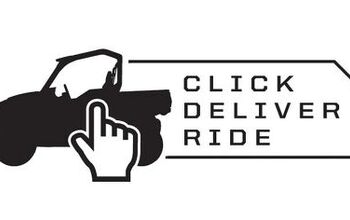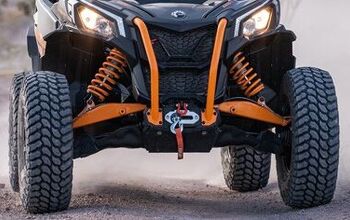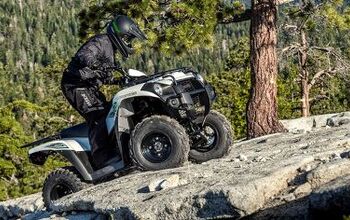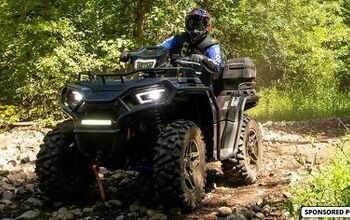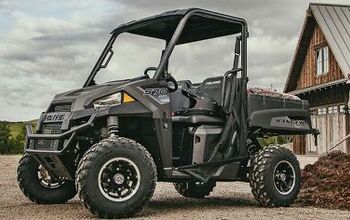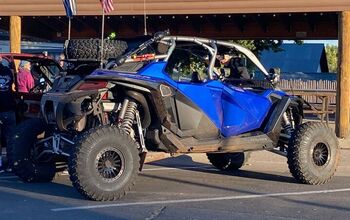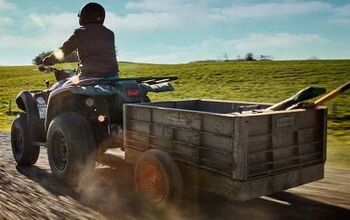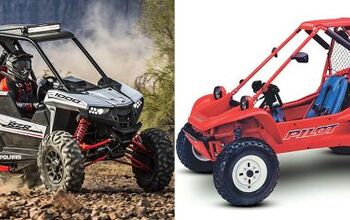How to Buy a UTV
“Honey, you know how the trail to our camp is really muddy and rough, hey?”
I always add the “hey” when I’m about to ask something to which I know the answer will more than likely be negative.
“Well, I was thinking that if we had one of those side-by-side ATVs, we could go into the camp together and getting in over the trail wouldn’t be a problem.”
A moment of silence, then a reply. “Okay, maybe you should get one then.”
And so began the search for a side-by-side ATV, or UTV, or RUV, or whatever they are called. I anticipated a quick drive around to a few dealerships to size up each of the offerings from the various manufacturers, and expected I’d be in my new side-by-side before the weekend. I mean, how many options could there be in the seemingly young side-by-side market?
Well, too many to mention actually.
Jason Lannon, left, owner of M&F Motors in Stephenville, Nfld., shows potential buyer Bill Oliver the features on the Yamaha Rhino.
You would expect the major players in the ATV market to each have a side-by-side model, but this is not the case. Polaris, Yamaha, Arctic Cat and Kawasaki all have them, and Honda is to debut its side-by-side, Big Red, next summer as a 2009 model. Suzuki and Can-Am (BRP) have yet to enter the fray, and it’s unclear if either will unveil a new model any time soon.
What I didn’t expect was to see side-by-sides being offered by John Deere, Kubota, Husqvarna, E-Z-Go, Club Car, Pug (are they still around?), and other manufacturers which I had never heard of.
Obviously, many of these companies make their off road vehicles for very specific clients, and while they all fall into the side-by-side category, not all of them are intended for the purpose of actually venturing very far off road.
With that in mind, it was time to set some criteria to help narrow my choices and ensure I got the vehicle that was going to best address my needs and wants.
So, what did I need? What did I want?
I needed ground clearance. The ‘trail’ that will serve as the weekly challenge for this UTV is a nightmare during any season other than winter (two-wheel drive ATVs cannot make it in there unassisted), with deep mud holes and hidden stumps and logs.
I needed a four-wheel drive (with differential lock), for the same reason I needed the ground clearance.
I needed a dumping box, preferably with lift assist. I plan to haul a lot of rock during the summers—to try and fill in some of those mud holes along the trail—and a tilting box would make things much easier.
I needed a tow-hitch receiver. Some of these side-by-sides can tow more than 1,000 lbs, and I can imagine lots of ways to take advantage of that.
I needed a vehicle that could work hard when called upon, but also be fun to drive when the work was done. All work and no play… and I should just buy a tractor.
I needed accessories. I want to have the option of adding a cab enclosure, windshield and the necessary winch, and the possibly of adding a heater, stereo, windshield wiper—basically, the greater the line of accessories, the better.
I wanted the vehicle to fit in the back of a pick-up (but having to trailer it is also an option, so this was not a ‘need’), and I wanted a powerful, fuel injected engine.
I also wanted to purchase locally (from a dealer within 50 or so miles of my home town), so getting parts, accessories and repairs would not require too much effort.
This last one eliminated many of the manufacturers, leaving only those currently dominating the side-by-side market (Yamaha, Polaris and Arctic Cat) and those better known for building tractors or lawn mowers. The fun factor (30 mph is not fun), and several other requirements helped narrow the list down to the big three.
Arctic Cat’s Prowler, the longest, widest and tallest of the UTV options studied, is available in three models for 2008.
Arctic Cat Prowler
The longest, widest, and tallest of the standard UTVs on the list comes from Arctic Cat. The Prowler is available in three models for 2008—the 650 H1, XT 650 H1 and XTX 700 H1 EFI.
If the prices were the same, the top-of-the-line XTX 700, with its 45hp electronic fuel injected engine, would appear to be the way to go. However, the price is not the same, and aside from the five extra horses, the convenience of EFI and an extra X in its name, the 700 offers little else over its 650 sibling. The XTX tops out at 55 mph—4 mph faster than the other models, and apparently comes with nicer paint (if you think that’s important), but it can only accommodate a 350-pound load in the rear pan. The XT and base Prowler are both capable of carrying 600 pounds of cargo.
Ground clearance for the big Cats is unmatched in the class, with the lowest point of the Prowler’s underbelly hovering 12.5 inches above the terrain. Dimensions for the big Cat include a width of 61.3 inches, a length of 115 inches, a wheelbase of 75 inches and height of 77.5 inches.
Because of its height, one might think the Prowler’s centre of gravity is high, making the vehicle prone to tipping. But Arctic Cat uses 14-inch wheels on its UTV line, meaning its tires have a shorter, stronger side wall (the ATV version of ‘low profile’). A sway bar on the XT and XTX models should also help correct some of the taller Cat’s cornering issues.
The Prowler tips the scales at 1,160 pounds and has a towing capacity of 1,500 pounds. Stopping power is provided courtesy of hydraulic disc front and rear, while fully independent double a-arm suspension helps make for a smooth ride. If your wife’s only concern is color, the Prowler is available in red, dark green, the bright Arctic Cat green, and camo. The XTX only comes in metallic silver.
Page 2Yamaha Rhino
If the Prowler is among the biggest of the two-passenger UTVs, Yamaha’s Rhino is among the smallest (the Polaris RZR 800 is smaller, but that doesn’t make the list because it doesn’t have a dumping box). Length is 113.6 inches, width 54.5 inches. The wheelbase spreads over 75.2 inches, and the rig’s highest point is 73 inches from the ground.
The Rhino is also probably the best known of the UTVs. This model is so common the name ‘Rhino’ is often used to imply any side-by-side, regardless of manufacturer (like calling any snowmobile a Ski-Doo).
Despite its smaller dimensions, though, the Yamaha is a true off-road UTV, capable of going pretty much anywhere you point it.
The Yamaha Rhino is among the smallest machines examined, at 113.6 inches long and 54.5 inches wide.
For 2008, Yamaha introduces a 700 fuel injected engine to the line-up. A carbureted 660 and 450 are also available.
The little Yammy weighs in at 1,124 pounds and is rated to tow about 100 pounds more than that. The Rhino’s steel cargo box can handle a 400 pound payload (the Arctic Cat and Polaris cargo boxes are made from dent-resistant plastic), and comes with a heavy rubber cargo bed mat to help protect the metal from dents and scratches.
Ground clearance on the Rhino is 11 inches and, like the competition, features independent suspension front and rear. It also has four wheel disc brakes, which seem to be the standard for this class.
Rhino colours for 2008 are listed as red and dark green, but if you can find models still remaining from last year, other color options may be available.
The Polaris Ranger, the most utilitarian of the models, comes with either a 500 (30 hp) or 700cc (40 hp) fuel injected engine.
Polaris Ranger
The most utilitarian of the models in our top three, the Polaris Ranger is available with either a 500 (30 hp) or 700cc (40 hp) fuel injected engine, with the 700 model being designated the XP.
Dimensions, including the 1,185-pound weight, are the same on both with the wheelbase extending across 76 inches, the length stretched to 113 inches, a width of 60 inches and a height of 75 inches.
The Ranger has an automatic clutch (similar to the other two), and has MacPherson struts on the forward corners, with independent suspension also soaking up the terrain in the rear.
While the other two models have the option of switching manually between two and four wheel drive (and four wheel differential lock), the Ranger utilizes an all wheel on-demand system.
Like the system on its ATV line, the Ranger’s on-demand set up puts power only to the rear wheels under normal driving conditions. When extra traction is required, the two forward wheels are engaged automatically. Once traction is re-established, it switches back to two-wheel drive.
This should provide better fuel economy and may prevent drivers from getting stuck because they forget to engage the four-wheel drive system (or don’t have time to engage it) when conditions change unexpectedly.
All of these UTVs have a wide range of accessories. However, Polaris would seem to have an edge in the category with their well-established Lock and Ride line. Color options include green and red, with Mossy Oak (camo) also available for the XP.
Top speed among all the models varies from a low of 41 mph (the 400 Ranger), to a high of 55 mph (the 700 Prowler XTX).
And the winner is…
Well, that’s still unclear.
The standard warranty for these vehicles is only six months, so unless you live in an area where the UTV can be driven through the winter, it’s probably best to wait until the spring before buying. There’s no sense in letting the warranty expire while your machine sits in the garage.
Cost is usually a consideration, though each manufacturer’s suggested retail price for similarly equipped models is about equal, so it’s not really an issue in this case.
Without having an opportunity to drive all three, I’m hesitant to choose one model over the other. More than likely, if your needs are similar to mine, you would be happy with any of the above. Perhaps the deciding factor is the level of service you will receive from your area dealer after you purchase your UTV.
Stephen Lee will continue to research this topic and will test drive the three models of UTV in this article in the spring of 2008. We’ll update you on what he finds out and we’ll review the vehicle he finally buys.
Related Reading:
More by ATV.com Staff



